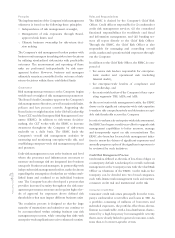American Express 2004 Annual Report Download - page 41
Download and view the complete annual report
Please find page 41 of the 2004 American Express annual report below. You can navigate through the pages in the report by either clicking on the pages listed below, or by using the keyword search tool below to find specific information within the annual report.
Description
Amount
(billions)
American Express Company
(Parent Company only):
Fixed Rate Senior Notes $ 0.5
American Express Credit Corporation:
Floating Rate Medium-Term Notes $ 2.6
Fixed Rate Medium-Term Notes $ 2.7
Borrowings under bank credit facilities $ 3.4
American Express Centurion Bank:
Floating Rate Medium-Term Notes $ 3.5
Fixed Rate Senior Notes $ 0.5
American Express Bank, FSB:
Floating Rate Medium-Term Notes $ 1.6
American Express Credit Account
Master Trust:
Trust Investor Certificates
(off-balance sheet) $ 3.9
Compared to the 2003 long-term funding activity, the
long-term debt issues in 2004 have longer average
maturities and a wider distribution along the maturity
spectrum to reduce and spread out the refinancing
requirement in future periods.
Beginning in late 2003, the Company also enhanced its
contingent liquidity resources for alternative funding
sources principally through the addition of an invest-
ment liquidity portfolio as discussed further in the TRS
Liquidity and Capital Resources section. The Company
believes that its funding strategy allows for the contin-
ued funding of business operations through difficult
economic, financial market and business conditions.
The Company’s funding strategy is designed to main-
tain high and stable debt ratings from the major credit
rating agencies, Moody’s, Standard & Poor’s and Fitch-
Ratings. Maintenance of high and stable debt ratings is
critical to ensuring the Company has continuous access
to the capital and credit markets. It also enables the
Company to reduce its overall borrowing costs. At
December 31, 2004, its debt ratings were as follows:
Moody’s
Standard
& Poor’s
Fitch
Ratings
Short-term P-1 A-1 F-1
Senior unsecured A1 A+ A+
See Note 23 to the Consolidated Financial Statements for
the rating agency response to the proposed spin-off.
The Company actively manages the risk of liquidity and
cost of funds resulting from the Company’s financing
activities. Management believes a decline in the Com-
pany’s long-term credit rating by two levels could result
in the Company having to significantly reduce its com-
mercial paper and other short-term borrowings.
Remaining borrowing requirements would be
addressed through other means such as the issuance of
long-term debt, additional securitizations, increased
deposit taking, the sale of investment securities or
drawing on existing credit lines. This would result in
higher interest expense on the Company’s commercial
paper and other debt, as well as higher fees related to
unused lines of credit. The Company believes a two
level downgrade is highly unlikely due to its capital
position and growth prospects.
Parent Company Funding
Total Parent Company long-term debt outstanding
was $5.7 billion at both December 31, 2004 and 2003.
During 2004, the Parent Company issued $500 million
of 4.75% Senior Notes due 2009 under the shelf regis-
trations to be used for general corporate purposes.
During 2003, the Parent Company issued $1 billion of
4.875% Senior Global Notes due in 2013 and $2 billion
of 1.85% Convertible Senior Debentures (the Deben-
tures) due in 2033. See Notes 1 and 7 to the Consoli-
dated Financial Statements for a more complete
discussion regarding the terms of the Debentures. See
Note 23 to the Consolidated Financial Statements for a
discussion of the potential effect of the proposed spin-
off of AEFA on the Debentures.
At December 31, 2004 and 2003, the Parent Company
had $4.3 billion and $1.8 billion, respectively, of debt
or equity securities available for issuance under shelf
registrations filed with the Securities and Exchange
Commission (SEC).
The Board of Directors authorized a Parent Company
commercial paper program supported by a $1.96 bil-
lion multi-purpose committed bank credit facility that
expires incrementally through 2009. There was no Par-
ent Company commercial paper outstanding during
2004 and 2003, and no borrowings have been made
under its bank credit facility. The Company maintained
total committed bank lines of credit with approxi-
mately 54 large financial institutions totaling $13.8 bil-
lion at December 31, 2004, which include the Parent
Company credit lines. The availability of the credit lines
is subject to the Company’s compliance with certain
financial covenants. See TRS’ Liquidity and Capital
Resources discussion for details of the principal cov-
enants that govern this committed bank credit facility.
See Note 23 to the Consolidated Financial Statements
for a discussion of the impact of the proposed spin-off
on the Company’s credit lines.
In addition, TRS; Centurion Bank; Credco; American
Express Overseas Credit Corporation Limited, a
AXP
AR.04
39
Financial Review
























